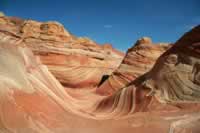Grand Canyon
The Grand Canyon - Arizona's Natural Wonder of the World
One almost has to see it to believe its great beautiful depths -
and of course many flock from around the world to get a good look
at this natural wonder - about four million visitors per year.
Visitors can marvel at the more than 6,250 feet of river-carved
geology - a feat of nature and nothing like it can be found
elsewhere in the world. The following article describes this
grandest of canyons and the many splendours to be discovered and
enjoyed in its region.
The first Europeans to witness the spectacular sight of the
canyon were Spanish explorers around 1540; however, its first true
inhabitants made it their home about eleven thousand years ago. It
is also home to a wide array of animal life: about 285 species of
birds, 88 different mammals, 50 types of reptiles and 8 amphibians.
The south-western boundary of the Grand Canyon is also home to the
Havasupai Indian Reservation which attracts many visitors as
well.
In order to travel from one end of the canyon to the other, a
277 mile journey down the mighty, and cold, Colorado River would be
required. Such a trip down the length of the canyon allows
onlookers to witness the canyons two billion years of geology. And
what's more, the Colorado continues to shape and carve the canyon
as it flows southward. Most visitors prefer the view of the canyon
from the South Rim; it is the most widely visited and the area is
the seat of most tourist activities.
The geology of the canyon is the core of its majesty. In fact,
scientists can find no better place on the planet to study the
formation of the earth. Nearly two billion years of geological
history are exposed for viewing - from the Palaeozoic era rim tops
to the Precambrian era inner canyon. The canyon is also great
viewing for fossil enthusiasts studying the earliest life forms of
the planet. There are many specific geological features of the
canyon that draw individual attention such as the Inner Gorge and
Toroweap Point.

The Wave, Vermillion Cliffs
While one could never truly tire of witnessing the canyon's
magnificent geological formations, the flora and fauna of the
canyon and its surrounding areas are noteworthy in themselves. The
broad assortment of animals in the area brings the whole setting to
life. Great Horned Owls as well as Red-Tail Hawks are a few of the
canyons avian hunters. Other birds typically seen in the area
include the Western Kingbird, Hairy Woodpecker and Black-Throated
Sparrow. Also, don't be surprised to see a Roadrunner zipping
around.
Other animals to be found in and around the canyon include black
bears, prong-horned antelope, mule deer, bobcats, beavers,
squirrels, grey foxes, chipmunks, skunks, bighorn sheep, coyote,
jackrabbits, rattlesnakes, king snakes, various lizards and plenty
of fish in the river itself.
The flora of the canyon and surrounding areas differs
substantially from the top to the bottom of the canyon. Even the
North Rim is very different in terms of vegetation than the South
Rim, so a varied presentation of tree and plant life is to be had
across the areas of the Grand Canyon. Visitors often admire such
trees as blue spruce, ponderosa pine, one-seed junipers and blue
elderberries as well as Douglas fir and bigtooth maple. Other forms
of plant life include cliff-roses, agave, desert marigold, barrel
cactus, prickly pear, yuccas, weedy herbs, sagebrush, sunflowers,
Indian paintbrush and many more that are breathtaking to
behold.
Visitors to the Grand Canyon have many ways to enjoy it. Whether
appreciated at the top or at the bottom, people may view the canyon
from the many designated lookout spots or watchtowers; some people
choose to hike into the canyon and camp. Still others prefer a raft
trip down the river. No matter how you choose to view and enjoy the
canyon, you are destined to never forget your experiences at the
Grand Canyon.
Grand Canyon All American Helicopter Flight 50%
off. Book now at Viator